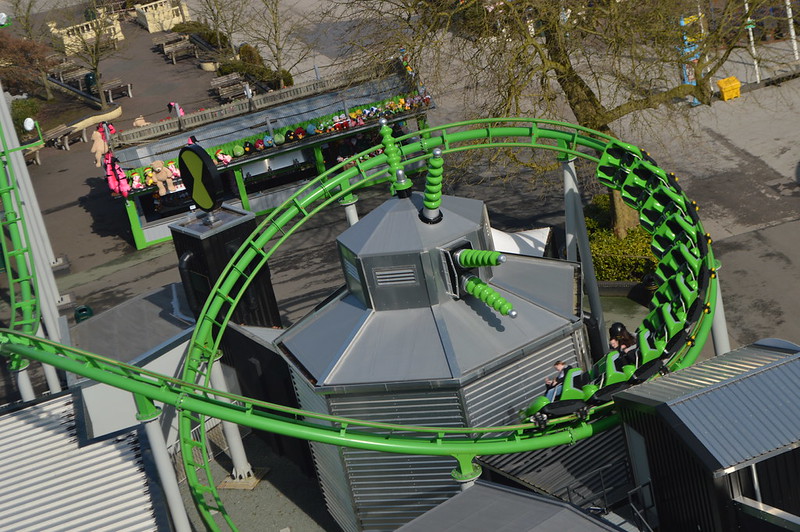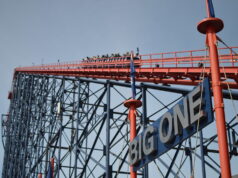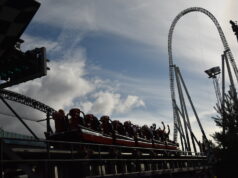Few roller coasters have achieved the global presence and recognition of the Vekoma Boomerang. Since its introduction in the mid-1980s, the Boomerang model has become one of the most repeated roller coaster layouts in the world, appearing in more than 50 amusement parks across Europe, the United States, and Asia.
Its enduring appeal lies in a combination of compact design, thrilling inversions, and adaptability, making it a favourite for both park operators and riders alike.

In Europe, where Vekoma is based, the Boomerang has taken many forms and been creatively integrated into themed areas. Phantasialand’s Raik in Germany is a striking example of this, set within the Nordic-inspired Klugheim area. Unlike classic Boomerangs that focus purely on thrills, Raik delivers a family-friendly experience while maintaining the shuttle layout’s signature forward-and-backward motion.
In Finland, PowerPark’s Cobra follows the traditional Boomerang design, with the familiar cobra roll and loop elements. While Cobra is less heavily themed than Raik, the ride emphasizes the classic Boomerang thrill, demonstrating how even subtle design changes and placement can influence the rider’s experience.
Across Europe, the newer Family Boomerang variants have found a home in parks such as Drayton Manor in the UK, offering non-inverting thrills for younger guests while retaining the essence of the shuttle coaster.

In the United States, Boomerangs have been installed in numerous parks, often emphasizing raw coaster excitement over immersive theming. The classic layout, with a chain lift hill followed by a cobra roll and a vertical loop, remains largely intact in these installations. Some parks have taken the model to new extremes with the Giant Inverted Boomerang, such as Aftershock at Silver Wood Theme Park.
These larger variants feature vertical lifts and inverted track sections, providing a visually impressive and adrenaline-packed ride experience. To improve comfort and reliability, many U.S. Boomerangs have received modern train upgrades, including the MK-1212 models, allowing riders to enjoy smoother rides without sacrificing the original design’s intensity.
Asia offers some of the most innovative interpretations of the Boomerang concept, blending cutting-edge engineering with immersive theming. The Super Boomerang at Xuzhou Fantawild Wonderland in China represents a bold evolution of the classic layout.
Using linear synchronous motor launches instead of the traditional chain lift, this multi-launch coaster reaches speeds of up to 95 km/h and features multiple inversions and airtime moments. The ride’s towering structure and modern aesthetic make it a landmark within the park and a visually striking reinterpretation of the shuttle concept.
Elsewhere in Asia, parks like Enchanted Kingdom in the Philippines have introduced traditional Boomerangs themed around space exploration, drawing on real-world inspiration to add context and excitement to the ride experience. These variations demonstrate how the Boomerang design can be adapted to both futuristic and narrative-driven settings, extending its appeal across different markets.
The thematic approach to Boomerang coasters varies significantly by region. In Europe, many Boomerangs are integrated into story-rich areas of the park, providing a sense of place and narrative alongside the thrills. U.S. parks often focus on the pure ride experience, highlighting speed and inversions rather than creating an immersive environment.
In Asia, both immersive theming and technological innovation come together to push the boundaries of what the Boomerang can deliver, offering riders both spectacle and performance.
Despite its popularity, the Boomerang design is not without criticism. Some riders note that older installations can feel rough, particularly on the backward return, and reliability can be an issue due to the shuttle system and single-train operation.
Capacity limitations can also be a concern for busy parks, but these challenges have not diminished the ride’s global presence or appeal. In fact, Vekoma has continued to evolve the concept, with new models and improvements in train design and launch technology keeping the Boomerang fresh for modern audiences.
Ultimately, the Vekoma Boomerang stands as a testament to the enduring appeal of a well-designed roller coaster. Its adaptability has allowed parks around the world to tailor the experience to their unique themes, guest demographics, and spatial constraints.
From European family areas to American thrill zones and Asian technological marvels, the Boomerang continues to captivate riders while proving that even a decades-old design can evolve in exciting and imaginative ways.
Got an opinion? Share your thoughts with us over on our Facebook page @UKThemeParkSpy — your voice matters in the theme park community!









Wow, I didn’t know there were so many types of Boomerangs!
I didn’t know they were so popular in different parts of the world.
I don’t understand why people rave about these coasters. They’re outdated and not thrilling at all. Just a bunch of loops with no real excitement.
Definitely wipeout